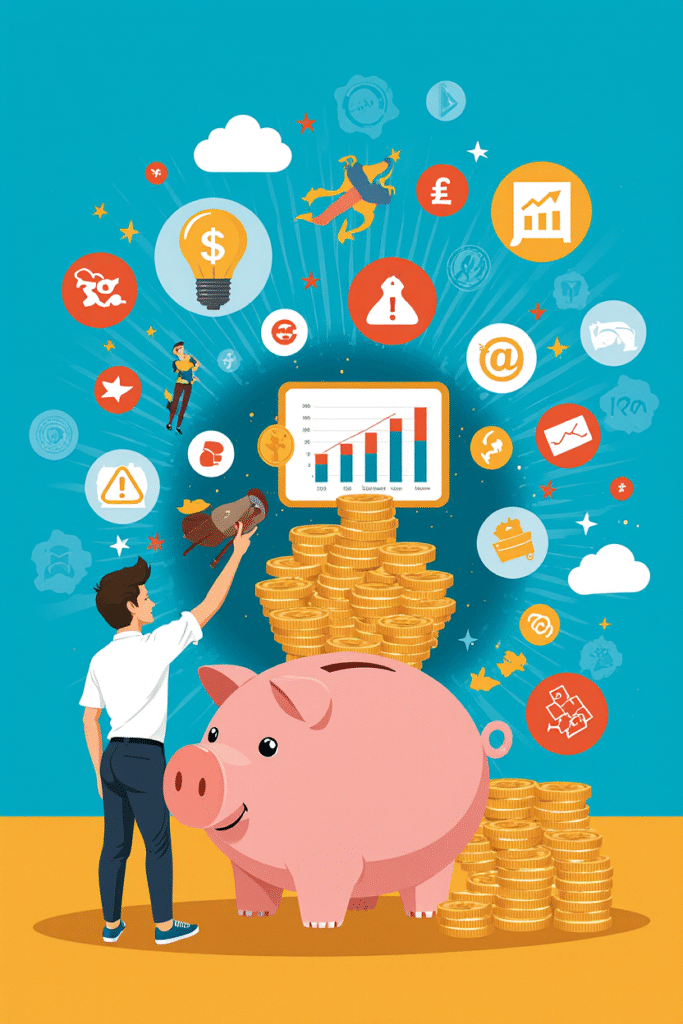Building a Bulletproof Emergency Fund: What’s Enough in 2025?
If the past few years have taught us anything, it’s this: life is wildly unpredictable. One minute you’re cruising with a steady paycheck and manageable bills — the next, you’re hit with a layoff, a rent hike, or a medical emergency that throws your entire budget into chaos. That’s why an emergency fund isn’t just good advice in 2025 — it’s a financial must-have. And the old “save three months of expenses” rule? It might not cut it anymore.
In this comprehensive guide, we’ll dive deep into how to build (and protect) an emergency fund that’s strong enough to survive today’s inflation, job instability, and rising cost of living — without feeling like you’re cutting every joy out of your life.

Why Emergency Funds Are Non-Negotiable in 2025
The world has changed, and so has the financial landscape. Here’s what’s different now:
🔥 Inflation Is Sticky
Prices have remained stubbornly high since the 2020s. Grocery bills are up, rent is surging in many cities, and even basic insurance premiums have spiked. According to the U.S. Bureau of Labor Statistics, consumer prices continue to outpace wage growth in many areas.
A $1,000 emergency fund in 2019 might have felt like a cushion. Today, it might barely cover one unexpected medical visit.
🧯 Job Market Volatility
With the rise of automation and widespread layoffs in tech, media, and finance sectors, job stability is increasingly rare. A Pew Research study confirms that job losses have affected younger and lower-income workers more harshly in recent years.
🚨 Emergencies Are More Expensive
Car parts cost more. Health care deductibles are higher. One unplanned event can cost thousands — and it usually happens when you least expect it.
What Exactly Is an Emergency Fund? (And What It’s Not)
An emergency fund is liquid money set aside specifically to cover unexpected expenses. Think of it as your personal insurance policy against the chaos of life.
It is not:
- A vacation savings fund
- A backup for overspending
- Your investment portfolio
✅ What Makes a Good Emergency Fund:
- Easy to access in under 24 hours
- Separate from your main checking account
- Not subject to market risks
- Strictly reserved for emergencies
Keep it boring. Keep it safe. Keep it ready.
How Much Emergency Fund Do You Need in 2025?
The “3 to 6 months” rule still applies — but with nuance. Your ideal emergency fund amount depends on several factors:
📊 1. Income Stability
- Steady salary + dual-income household?
→ Save 3–4 months of essential expenses. - Freelancer, gig worker, or sole earner?
→ You need 6–12 months. Err on the side of caution.
👨👩👦 2. Number of Dependents
Supporting kids, a partner, or aging parents? Your emergency fund needs to reflect their needs too — especially health, childcare, and housing.
💵 3. Cost of Living
A $3,000/month cushion may work in a small town — but not in San Francisco or NYC. Adjust for your region’s average rent, utilities, and groceries using tools like Numbeo.
Breakdown: What Should Be Included in Emergency Fund Calculations?
When estimating your monthly “bare bones” expenses, include:
- Rent or mortgage
- Utilities (electricity, water, gas, phone, internet)
- Groceries
- Transportation (gas, public transit, insurance)
- Health insurance premiums or COBRA
- Minimum debt payments (credit cards, student loans)
- Childcare or pet expenses (if applicable)
👉 Leave out: Dining out, subscriptions, entertainment, clothing, and vacations. The goal is survival mode, not lifestyle maintenance.
Where to Store Your Emergency Fund in 2025 (And Still Earn Something)
In the past, storing cash meant earning near-zero interest. Thankfully, that’s changed.
💡 Best Places to Keep Your Emergency Fund Now:
- High-Yield Savings Accounts (HYSA):
Many are offering 4%–5% APY in 2025. Reputable banks like Ally, Marcus by Goldman Sachs, and Synchrony offer excellent options. - Money Market Accounts:
Slightly higher returns, sometimes with check-writing privileges. Useful if you want a bit more flexibility. - Cash Management Accounts (CMAs):
Ideal for freelancers or gig workers — often offer better integration with budgeting tools. Wealthfront and SoFi offer solid CMA options.
🚫 Avoid:
- CDs (can lock your money in)
- Brokerage accounts or stocks (too volatile)
- Crypto (not stable enough for emergencies)
Emergency Fund Strategies for High Inflation (2025 Edition)
With inflation hovering above historical averages, you’ll need to be proactive.
📈 1. Adjust Regularly
Recalculate your emergency fund goal every 3–6 months. If your rent, groceries, or premiums go up, your fund target should too.
🪙 2. Use Tiered Saving
Split your fund:
- First 3 months: Liquid HYSA (instant access)
- Next 3–6 months: Money market for slightly higher returns
This strategy helps you balance access and growth.
🎯 3. Automate & Ignore
Automate transfers to your savings account every payday. Even small amounts build up fast — and automation removes the temptation to skip.
How to Build an Emergency Fund from Scratch (Even If You’re Broke)
Yes — even if you’re paycheck to paycheck, you can do this.
Step-by-Step Game Plan:
✅ 1. Start with $500
This is your mini-goal. Just enough to cover small car repairs or medical co-pays.
✅ 2. Automate a Small Weekly Transfer
$10–$25/week adds up. Tie it to payday so you won’t miss it.
✅ 3. Save Windfalls
Tax refund? Bonus? Birthday money? Drop a chunk into your emergency fund before you spend the rest.
✅ 4. Cut One Non-Essential
Pause one streaming service. Skip takeout one night a week. That saved $15–$50 can go straight into your savings.
✅ 5. Use Round-Up Apps
Apps like Acorns and Qapital automatically round up purchases and deposit the spare change into savings.
Or — try this beginner-friendly tactic: Save Loose Change and Watch Your Savings Grow. It’s simple, practical, and surprisingly effective for emergency fund beginners.
When Should You Use Your Emergency Fund? (And When You Shouldn’t)
Use it for:
- Job loss or major pay cut
- Emergency travel (death or illness in family)
- Car breakdown or home repair you must fix
- Unexpected medical bills
Don’t use it for:
- Concert tickets or flash sales
- Regular monthly bills you forgot to budget for
- Non-essential travel or entertainment
- A new phone or upgrade (unless your old one died)
🚨 Rule of Thumb: If it doesn’t threaten your safety, shelter, or income — it’s not an emergency.
Common Mistakes That Can Undermine Your Emergency Fund
Even savers with good intentions make these missteps:
❌ Relying on Credit Cards
It’s tempting, but expensive. Interest adds up fast — and relying on debt isn’t financial security.
❌ Investing Your Emergency Fund
The market is for long-term growth — not short-term emergencies. Keep your fund safe, even if returns are modest.
❌ “Borrowing” From It
Once you dip into your emergency fund for a vacation or shopping spree, it’s no longer an emergency fund. Treat it like sacred money.
Emergency Fund FAQs (2025)
Q: Should I build an emergency fund or pay off debt first?
A: Do both — but prioritize a mini emergency fund of $500–$1,000 first. Then tackle high-interest debt, while still contributing small amounts to savings.
Q: What if I already have savings, but they’re not labeled ‘emergency’?
A: Easy fix: split your savings into buckets. Use a second account or create labeled sub-savings within your bank app.
Q: I have an emergency fund — now what?
A: Great! Start building a buffer for planned expenses next — like car maintenance, holiday spending, or health costs.
Final Thoughts: An Emergency Fund Is the Foundation of Financial Freedom
In 2025, building a strong emergency fund isn’t about fear — it’s about freedom.
It means you can face uncertainty with confidence.
It means a surprise bill won’t derail your future.
It means you don’t have to panic when life gets unpredictable.
Start small. Be consistent. Adjust as your life evolves.
An emergency fund is not just money in a bank. It’s peace of mind, a safety net, and the first step toward financial independence.
Want help getting started?
💡 Ask your bank to create a separate “emergency” savings account
🗓 Set a reminder to check your emergency fund status every 90 days
⚡ Use a round-up app or save loose change automatically





